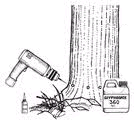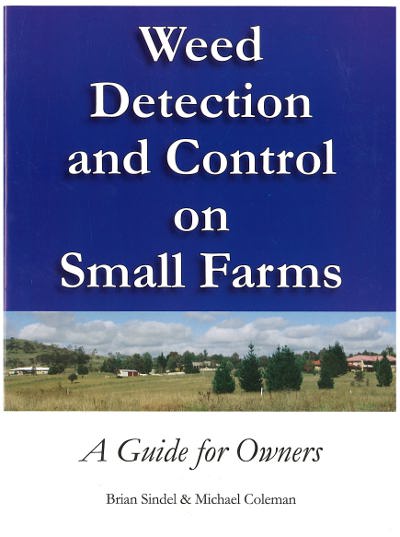Control Methods
Property and Machinery Hygiene
Good property and machinery hygiene can go a long way towards limiting the spread of weeds. Keep in mind the following:
- All machinery must be thoroughly cleaned to remove weed material before entering the property, and should only travel on established tracks.
- Hold new stock in a small paddock to let weed seeds pass through their system or fall off their coats.
- Giant Parramatta Grass and Coolatai Grass are mainly spread by vehicle and stock.
- Use equipment in the cleanest paddocks before treating weedy paddocks.
- Have a wash down area and thoroughly clean equipment after use.
- Only feed out introduced feeds (hay, silage, etc) within set areas. These areas should be arable in case they need to be re-sown because of weed seed contamination.
- In dams and water features, use only native species as exotics may be invasive.
- Regularly inspect for new occurrences of weeds, especially around your farm entrance, holding yards, wash down areas, sheds, access tracks, creeks, dams and feed out areas.
- Maintaining boundary fences in a stock proof condition
Weed Control Methods
For information on the approved techniques for controlling noxious weeds.
Complete Removal

Necessary for plants which regrow from bulbs, tubers or other plant parts eg runners. Remove all plant parts by hand pulling.
Stem Scraping
Stem scraping is used for plants and vines with aerial tubers. A sharp knife is used to scrape a very thin layer of bark from a 10 cm section of stem. Herbicide is then immediately applied to the exposed soft underlying green tissue.
This method is also called bark stripping or stem painting. Some woody weeds can have their bark surface peeled away and the exposed wood painted or sprayed with herbicide.
Cut Stump
 The cut stump method involves cutting the plant off completely at its base (no higher than 15 cm from the ground) using a chainsaw, axe, brushcutter or machete (depending on the thickness of the stem/trunk). An herbicide solution is then sprayed or painted onto the exposed surface of the cut stump emerging from the ground, with the objective of killing the stump and the root system.
The cut stump method involves cutting the plant off completely at its base (no higher than 15 cm from the ground) using a chainsaw, axe, brushcutter or machete (depending on the thickness of the stem/trunk). An herbicide solution is then sprayed or painted onto the exposed surface of the cut stump emerging from the ground, with the objective of killing the stump and the root system.
It is imperative that the herbicide solutions are applied as soon as the trunk or stem is cut. A delay of more than 15 seconds for water-based herbicides and one minute for diesel-soluble herbicides between cutting and applying the chemical will give poor results.
Two operators working as a team can perform this method effectively. The herbicide can be applied from a knapsack, or with a paint brush, drench gun or a handheld spray bottle. It is a good idea to use a brightly coloured dye in the solution to mark the stumps that have been treated.
For trees with large circumferences, it is only necessary to place the solution around the edge of the stump (as the objective is again to target the cambium layer inside the bark). The stump circumference should be bruised with the back of an axe and each successive blow treated with herbicide.
This method has the appeal of removing the weed immediately, and is used mainly for trees and woody weeds. This method is also referred to as cut and spray, or cut and paint.
Stem Injection
 The stem injection method involves drilling or cutting through the bark into the sapwood tissue in the trunks of woody weeds and trees. Herbicide is immediately placed into the hole or cut. The aim is to reach the sapwood layer just under the bark (the cambium growth layer), which will transport the chemical throughout the plant.
The stem injection method involves drilling or cutting through the bark into the sapwood tissue in the trunks of woody weeds and trees. Herbicide is immediately placed into the hole or cut. The aim is to reach the sapwood layer just under the bark (the cambium growth layer), which will transport the chemical throughout the plant.
It is essential to apply the herbicide immediately (within 15 seconds of drilling the hole or cutting the trunk), as stem injection relies on the active uptake and growth of the plant to move the chemical through its tissue.
Drill and Fill method
This stem injection method is also referred to as tree injection, and is used for trees and woody weeds with stems or trunks greater than 5 cm in circumference.
This method uses a battery-powered drill to drill downward-angled holes into the sapwood approximately 5 cm apart. The placement of herbicide into the hole is usually made using a backpack reservoir and syringe that can deliver measured doses of herbicide solution.
The Sidewinder is a stem injection system created by a Queensland equipment manufacturer Sidewinder Injection Systems based at Noosaville. The Sidewinder consists of a backpack injector that uses an electric drill and screw nozzle to inject herbicide under high pressure, much like a hypodermic syringe for trees. Trials have shown that Sidewinder Injectors reduce the amount of chemical used by up to 50 times compared to other similar stem injection methods.
The Sidewinder is regarded as the most environmentally friendly technique, especially when plugs are used to seal injection points. Stem injection methods kill the tree or shrub where it stands, and only trees and shrubs that can be safely left to die and rot should be treated this way. If the tree or shrub is to be felled, allow it to die completely before felling.
Axe Cut Method
This method involves cutting through the bark into the sapwood tissue in the trunk, and immediately placing herbicide into the cut. Like the drill and fill method, the aim is also to reach the tissue layer just under the bark (the cambium layer), which will transport the chemical throughout the plant.
The axe cut method can be used for trees and woody weeds with stems or trunks greater than 5 cm in circumference.
Using an axe or tomahawk, horizontal cuts are made into the sapwood around the circumference of the trunk at waist height. While still in the cut, the axe or tomahawk is leaned out to make a downward angled pocket which will allow herbicide to pool. The herbicide is then immediately injected into the pocket. Cuts should be made no further than 3 cm apart. This method of using an axe to make the cut is often referred to as frilling or chipping.
This method can also be achieved using a hammer and chisel to make the pocket cuts, or a spear to make cuts in the trunk closer to ground. It is important not to entirely ringbark the trunk, as this will decrease the uptake of the herbicide into the plant.
Basal Barking
 This method involves mixing an oil-soluble herbicide in diesel and spraying the full circumference of the trunk or stem of the plant. Basal bark spraying is suitable for thin-barked woody weeds and undesirable trees.
This method involves mixing an oil-soluble herbicide in diesel and spraying the full circumference of the trunk or stem of the plant. Basal bark spraying is suitable for thin-barked woody weeds and undesirable trees.
Basal bark spraying is also an effective way to treat saplings, regrowth and multi-stemmed shrubs and trees. This method allows the herbicide to enter underground storage organs and slowly kill the targeted weed.
The entire circumference of the stem or trunk should be sprayed or painted with herbicide solution from ground level to a height of 30 cm. It is important to saturate the full circumference of the trunk, and to treat every stem or trunk arising from the ground.
Basal bark spraying is a very effective control method, and is a good way to tackle inaccessible areas such as steep banks. This method will usually kill difficult-to-kill weeds at any time of the year, as long as the bark is not wet or too thick for the diesel to penetrate. The work is often best performed by contractors.
Slashing and Mower
At times, controlling weeds using mechanical methods is the preferred method of weed control. However, care should be taken to avoid disturbing the soil or spreading weed seeds from machinery used in the process.
Disturbing the soil can increase the likelihood of weed seed germination. Native vegetation may also be damaged in the course of mechanical control. Prior to using mechanical means that involves native plants or weeds near waterways, please check legislative requirements.
In some cases it is possible to slash weeds using a tractor slasher or ride-on mower. Often this method is used where other favourable species will outgrow the slashed weeds. Some weed control contractors are trialling the use of steam to kill weeds. The steam is usually applied after the weeds have been slashed.
Bulldozers and chainsaws can be used on woody and tree weeds where they are pushed or felled and finally snigged (dragged away). These methods are only suitable in certain contexts, as they create high levels of soil and vegetation disturbance.
Shoots and seedlings also require follow up attention; however, this is not always possible in bushland settings.
Grading or scalping the top layer of soil is an effective method of removing a weed seedbank. As this method greatly disturbs the soil, it is best suited for areas that are to undergo complete rehabilitation.

|
 |
| The Weed Detection and Control on Small farms is also now available from the Moree Shire Council Offices free of charge or alternatively available as a pdf document online. | A guide to weed control in non-crop, aquatic and bushland situations - pdf document online |
Useful Websites
Useful Websites As a starting point, many of these online resources have good quality photos and list plants by common and scientific names. You could also enter a plant name into your favourite internet search engine to find information or images.
- Australian Pesticides & Veterinary Medicines Authority- search for herbicides registrations, permits.
- North West Weeds - local identification and treatment information on weeds within north-west NSW- also lists district spray contractors.
- NSW Dept of DPI ( Department of Primary Industries) - information on NSW weed control issues.
- Researchers at the University of Queensland developed the key to Environmental Weeds of Australia . The interactive weed identification tool helps you easily identify a weed based on the features of a plant. The tool includes over 1000 current and potential weeds.
- The Identify a Weed webpage on the Weeds Australia website provides an interactive database of weed descriptions and photos that can be filtered by plant location and plant habit.
- The Flora of NSW is online and allows plant name searches and provides identification keys as per the printed Flora of NSW. Detailed botanical descriptions, photos and illustrations are provided for most native and introduced plant species.
- NSW WeedAlert allows you to search for new records or extensions of range for weeds in NSW.
- The environmental weeds section of the Australian National Botanic Garden website has details of 19 species including their ecology, impact information and some photos.
- The Australian National Botanic Gardens Plant Image Index can be searched by family or scientific name.
- You can also often find photos and information on Australian environmental weeds on general gardening websites or other large image databases. Remember, some of these sites are from around the world, so they may describe native Australian plants as 'weeds'.